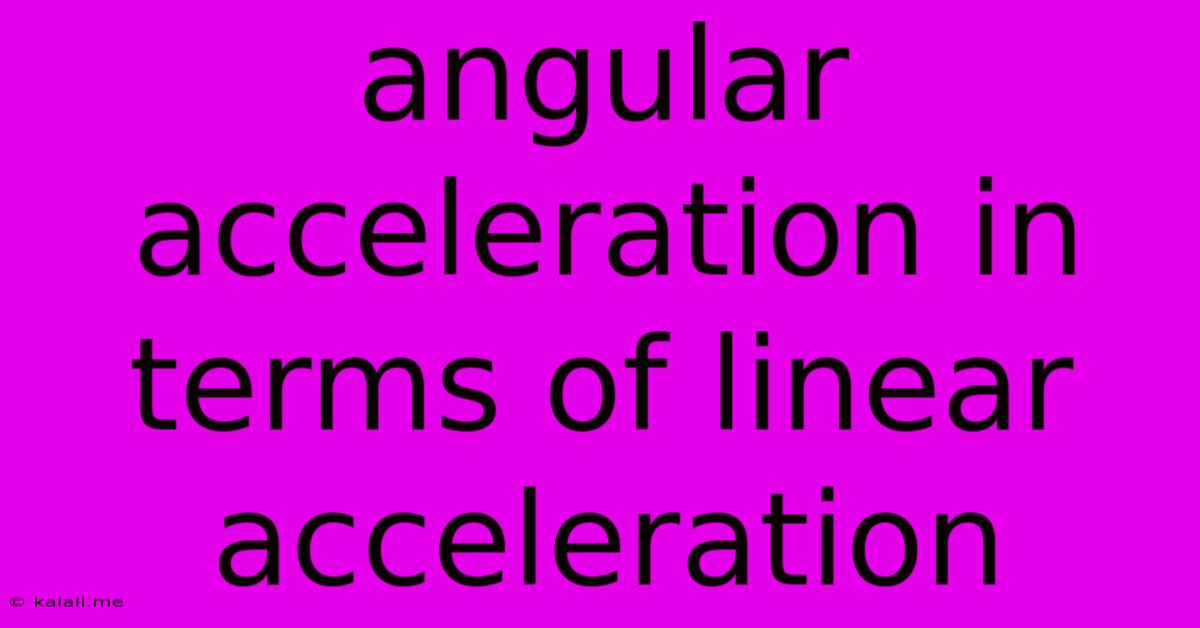Angular Acceleration In Terms Of Linear Acceleration
Kalali
Jun 16, 2025 · 3 min read

Table of Contents
Understanding Angular Acceleration: Its Relationship with Linear Acceleration
Angular acceleration and linear acceleration are fundamental concepts in physics, particularly crucial in understanding rotational motion. While seemingly distinct, they are intrinsically linked, especially when considering the motion of points on a rotating object. This article delves into the relationship between these two crucial concepts, explaining how they are connected and providing practical examples to solidify your understanding. Understanding this relationship is key to solving a variety of physics problems, from analyzing the motion of a spinning top to designing efficient rotating machinery.
Angular acceleration describes the rate at which an object's rotational speed changes over time. It's a vector quantity, meaning it has both magnitude and direction. The direction of angular acceleration is determined by the right-hand rule, indicating whether the object is speeding up (positive angular acceleration) or slowing down (negative angular acceleration). Linear acceleration, on the other hand, describes the rate of change of an object's linear velocity. This is also a vector, showing the change in speed and direction of linear motion.
The Connection: Radius and Tangential Acceleration
The key to understanding the link between angular and linear acceleration lies in the radius of the rotating object. Consider a point on a rotating object. This point experiences both angular and linear acceleration. The linear acceleration of this point can be broken down into two components: tangential acceleration and radial acceleration (centripetal acceleration).
-
Tangential Acceleration: This component of linear acceleration is directly related to angular acceleration. It's the acceleration that changes the speed of the point in its circular path. The formula connecting tangential acceleration (a<sub>t</sub>) and angular acceleration (α) is:
a<sub>t</sub> = rαwhere 'r' is the distance of the point from the axis of rotation. This equation highlights that for a given angular acceleration, points further from the axis of rotation experience a greater tangential acceleration.
-
Radial Acceleration (Centripetal Acceleration): This component is always directed towards the center of the circular path and is responsible for changing the direction of the point's velocity, keeping it moving in a circle. While not directly related to angular acceleration, it's essential in describing the overall linear acceleration of the point. It's calculated as:
a<sub>c</sub> = v²/r = ω²rwhere 'v' is the linear speed and 'ω' is the angular speed.
Total Linear Acceleration
The total linear acceleration (a) of a point on a rotating object is the vector sum of its tangential and radial accelerations:
a = √(a<sub>t</sub>² + a<sub>c</sub>²)
Practical Examples
-
A spinning wheel: Imagine a point on the rim of a spinning wheel that is undergoing constant angular acceleration. The tangential acceleration of this point will be constant, while the radial acceleration will increase as the wheel spins faster. The total linear acceleration will therefore also change over time.
-
A rolling ball: Consider a ball rolling down a hill without slipping. The point of contact with the ground has zero linear velocity, hence zero tangential acceleration, although the ball as a whole is experiencing linear acceleration down the hill. Other points on the ball experience both tangential and radial accelerations.
-
A rotating gear: In a gear system, understanding the relationship between angular and linear acceleration is crucial for calculating the speed and acceleration of the connected gears. A gear with a larger radius will have a larger linear speed and acceleration given the same angular acceleration as a smaller gear.
Conclusion
The relationship between angular and linear acceleration is fundamental to understanding rotational motion. By understanding how tangential acceleration relates to angular acceleration through the radius, and incorporating radial acceleration, we gain a complete picture of the linear motion of points on rotating objects. This knowledge is essential for various applications across physics and engineering. Mastering these concepts is key to unlocking more advanced topics in rotational dynamics and mechanics.
Latest Posts
Latest Posts
-
How To Create Clickable Image In Html
Jun 16, 2025
-
What Are The Factors Of 121
Jun 16, 2025
-
What Is A Theme Of The Passage
Jun 16, 2025
-
A Company That Provides Access To The Internet
Jun 16, 2025
-
Which Word Is Closest In Meaning To The Underlined Word
Jun 16, 2025
Related Post
Thank you for visiting our website which covers about Angular Acceleration In Terms Of Linear Acceleration . We hope the information provided has been useful to you. Feel free to contact us if you have any questions or need further assistance. See you next time and don't miss to bookmark.